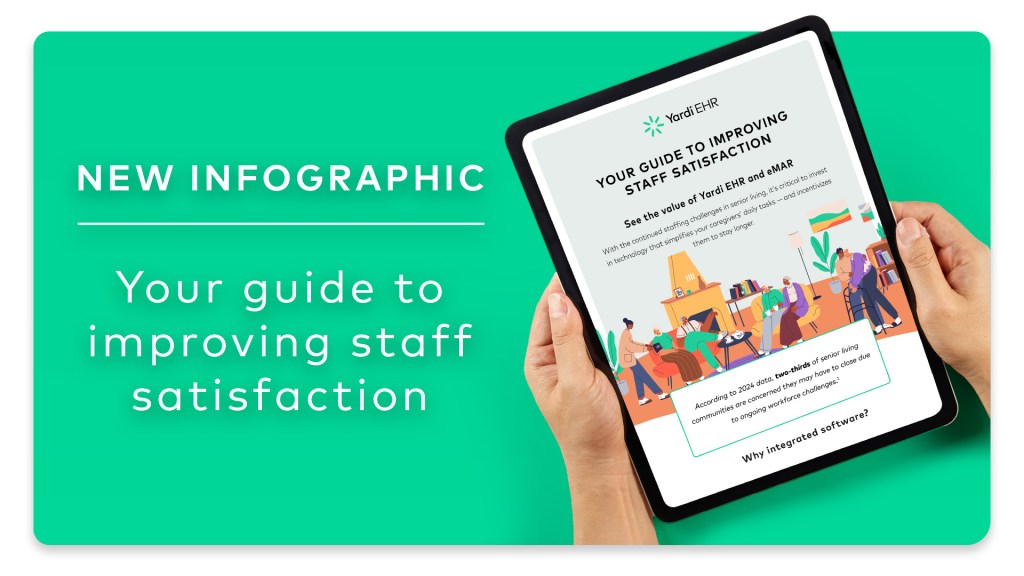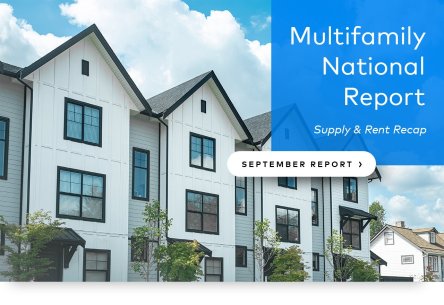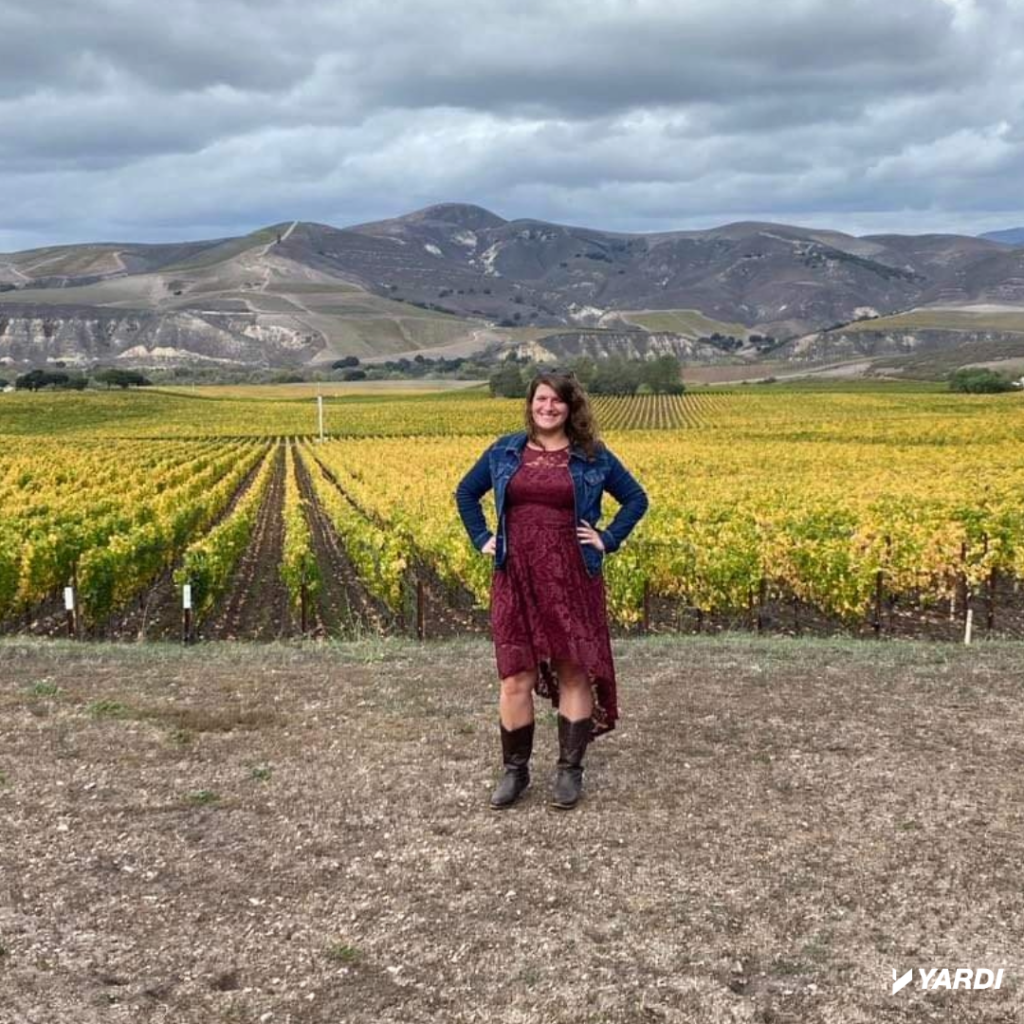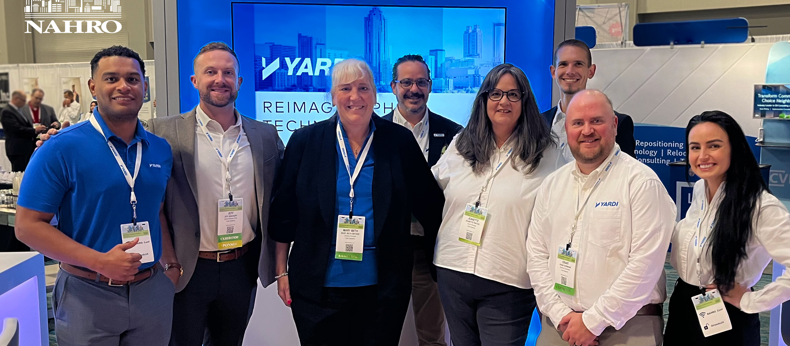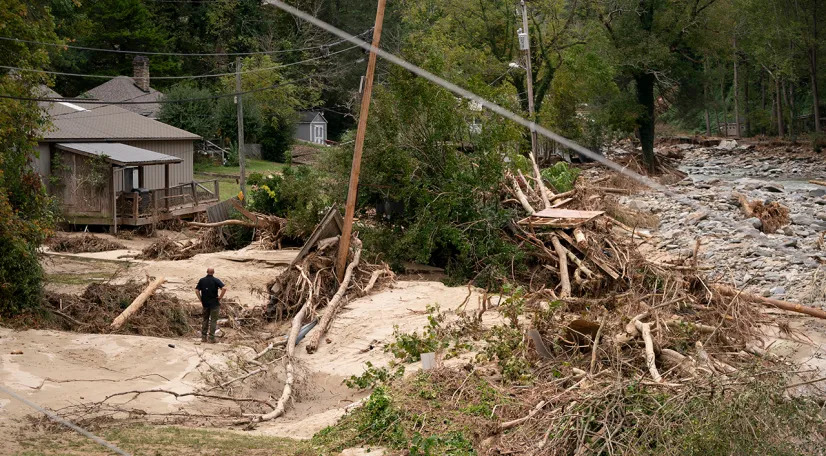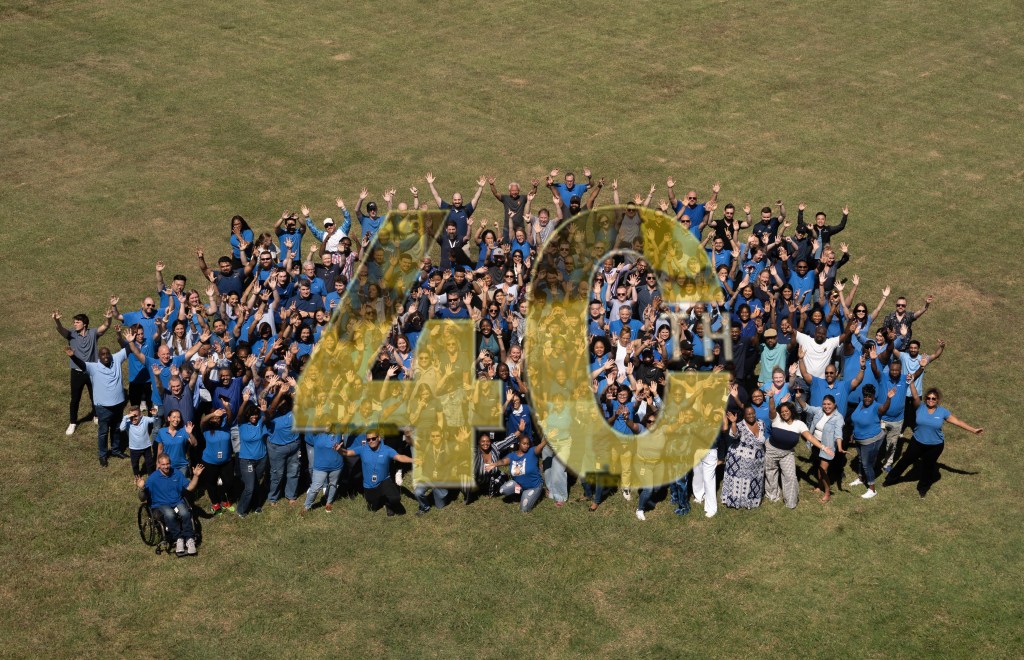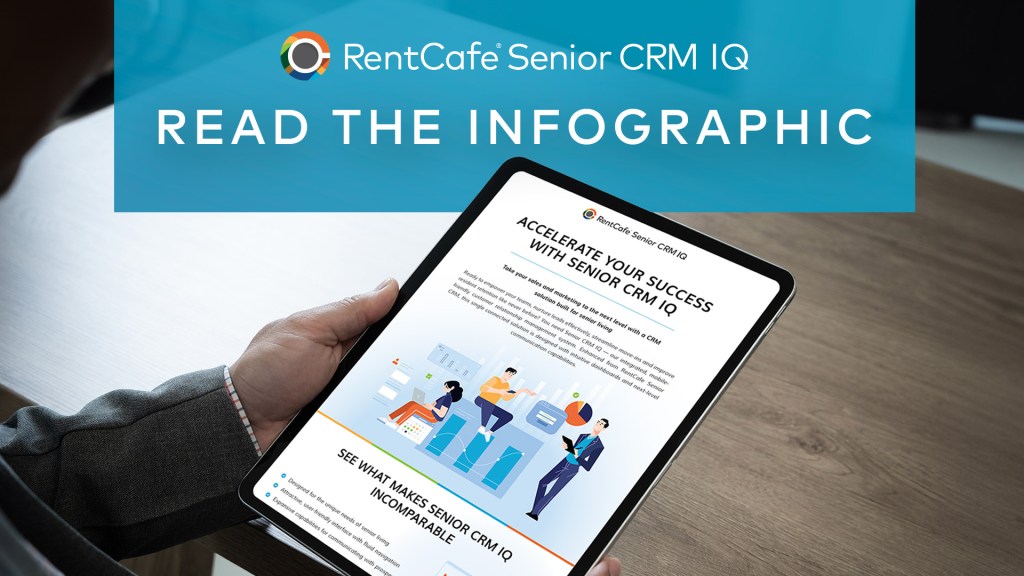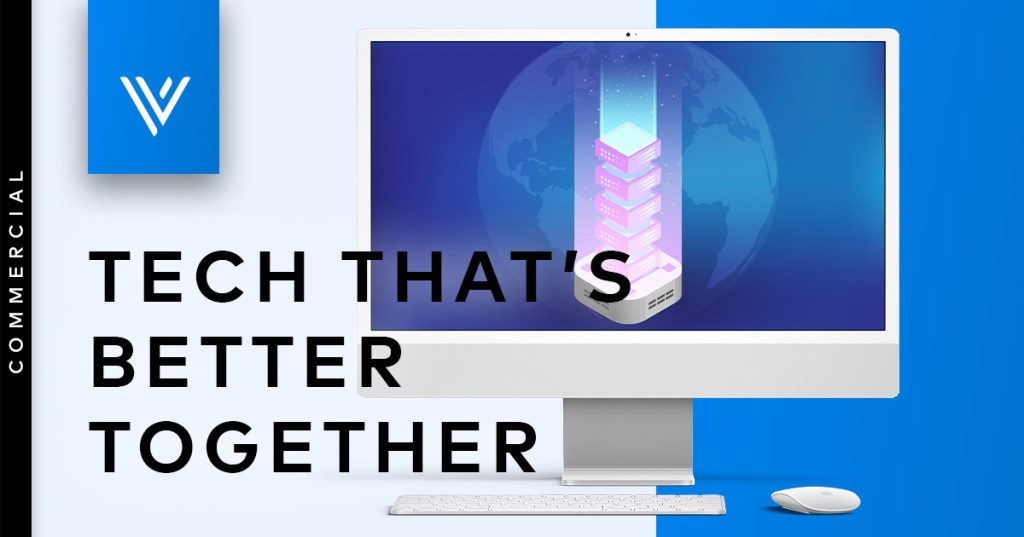With the continued staffing challenges in senior living, it’s critical to invest in technology that simplifies your caregivers’ daily tasks — and incentivizes them to stay longer. Explore this quick but comprehensive infographic to see exactly how technology can help you. Why integrated software? Paper processes are time-consuming and error-prone. Technology can help, but not when solutions are siloed and housed on different platforms. The burden these options create translates to staff feeling unsupported and overwhelmed, which leads to high turnover. Integrated software equips caregivers to view resident information, complete daily tasks and manage communications in one place. There’s no need to devote energy to arduous, manual administrative work, which allows them to focus on what matters most: resident care. With Yardi EHR and eMAR — fully integrated tools — you alleviate caregivers’ burden and boost satisfaction and retention. Why Yardi EHR? Gain executive health care oversight with clinical reporting, centralized resident records and instant access to financial data. View real-time health information and utilize convenient workflows, readily available at the point of care. Channel interoperability through verified interface partners that allow data to flow to and from Yardi EHR automatically. Free more time for residents with simplified record keeping, easy information sharing and reduced data-entry tasks. Utilize customizable dashboards and reports to easily manage resident care and optimize health outcomes. Access comprehensive clinical data and a staffing analysis workflow when you pair Yardi EHR with our business intelligence solution, Yardi Senior IQ. Why Yardi eMAR? Use an intuitive, customizable dashboard and workflows that adhere to state regulations and promote compliance. Reduce paper documentation, processing time and expenses with web-based records that eliminate manual medication administration tracking and medication reconciliation. Enhance care with a centralized platform for documenting vital sign data, lab orders, treatment plans and more. Incorporate automated billing based on medication orders and integrate financial analytics with medication administration. Gain a competitive edge with access to a growing market of pharmacy providers that have joined the Yardi Pharmacy Network. Eliminate discrepancies between care plans and medication administration, helping optimize staff shift assignments. Your success is our priority With Yardi, you can power your workforce strategy from a single platform. Reach out today to get...
Abandoned America
Historic - and Haunted? Ghost Towns
It’s the season to be a little spooked with thrills and shrills! Let’s explore why some cities in America have become ghost towns, and if being drawn to the mystery piques your interest, gather with some friends and uncover some real estate mysteries this fall. Many abandoned cities in America are due to the Gold Rush and industrial sites founded in the Gilded Age. Some began as lucrative mining communities that vanished almost overnight, and some are victims of new railways and infrastructure. Others were hit with natural disasters like tornados that flattened out the entire town. Hollywood movie producers and writers have been inspired and even filmed in a few. Pennsylvania. Being one of the most populous states in the country, Pennsylvania is home to many ghost towns and abandoned cities. On the western side of the state, in a suburb of Pittsburgh, Lincoln Way is an eerie little abandoned neighborhood that has become an attraction for urban explorers. Legend states that a “Beast of Lincoln Way,” a mysterious creature with glowing eyes and a haunting howl, terrorized residents, leading to the abandonment of the homes. In reality, it’s gloomier, with most residents moving away due to pollution from the emissions of the steel plant and older residents passing on. Still, many fascinating stories date back to the early 1900s, and in its final days, it is indeed an eerie, post-apocalyptic street. In eastern PA, Centralia was a thriving coal-mining town, but now, only a handful of people live there, mainly due to the coal mine that caught fire in 1962. The coal seen fueling the fire is expected to last another 250 years. This burning ghost town would not have even been recognized had it not been the inspiration for the 2006 horror...
Multifamily Update
From Yardi Matrix
Seasonality and supply are tempering advertised asking rent growth but demand remains strong, according to the latest Yardi Matrix National Multifamily Report. The average U.S. advertised asking rent decreased by $3 in September to $1,750, flat at 0.9 percent year-over-year (YoY). Occupancy stood at 94.8 percent in September, unchanged YoY. Gateway markets in the East and secondary markets in the Midwest continue to lead in YoY advertised asking rent growth, run by New York City (5.4 percent), Kansas City (4.2 percent) and Boston (3.4 percent). Supply increases continue to pressure asking rents in many Sun Belt metros, and the largest declines YoY were posted by Austin (-4.9 percent), Raleigh (-3.1 percent) and Phoenix (-2.4 percent). Post-pandemic demand has led to 1.7 million multifamily units absorbed between March 2020 and August 2024. All 132 markets surveyed experienced positive absorption, with Dallas (108,000 units) and Houston (71,000 units) in the lead. Single-family rentals advertised asking rents decreased $3 in September to $2,167, for a 0.6 percent YoY increase, with Kansas City (4.7 percent YoY) and Indianapolis (4.3 percent) posted the strongest growth. SFR occupancy declined 30 basis points to 95.3 percent in August. Gain more insight in the new Yardi Matrix National Multifamily Report. Yardi Matrix offers the industry’s most comprehensive market intelligence tool for investment professionals, equity investors, lenders and property managers who underwrite and manage investments in commercial real estate. Yardi Matrix covers multifamily, affordable housing, student housing, vacant land, industrial, office, retail and self storage property types. Email [email protected], call 480-663-1149 or visit yardimatrix.com to learn...
Will Frequencies
Become Rare?
Some observers consider radio frequencies the world’s most valuable natural resource and worry they could be depleted in the manner of other finite resources like clean air and water. Applications ranging from radio and television to cell phones, military systems, GPS and Wi-Fi use frequency bands of radio waves, a portion of the electromagnetic spectrum that includes microwaves, infrared, visible light, ultraviolet, x-rays and gamma rays. The use of radio frequencies by government and private entities is governed by the International Telecommunication Union (ITU), an international regulatory authority, and national authorities including the U.S. Federal Communications Commission. Frequencies are “the very foundation of all our wireless communications, and without them our modern life wouldn’t be possible as we know it,” says Swedish tech company LumenRadio. Flexibility from new tech But with billions of wireless devices currently in use and being developed rapidly filling up the frequencies allotted for commercial usage, could we run out of space on the radio frequency spectrum? “Yes, if you consider the number of white spaces and the limitations of existing technology to breach the high frequency barrier,” asserts ScienceABC.com, a repository of science facts. But exhaustion of this resource might not be imminent. Researchers are developing ways to utilize white spaces – frequencies that go unused to provide a buffer between radio signals that prevents interference – more effectively. New technologies for transmitting and receiving signals could eliminate both interference and the need to separate frequency bands. And some experts, such as internet pioneer and former MIT professor David Reed, are skeptical of the whole notion of a finite electromagnetic spectrum. “No single action is a silver bullet when it comes to meeting mobile capacity needs,” according to former FCC official Neil Grace. “More efficient use of spectrum, new...
Sam Valdés
Yardi Employee Profile
Yardi Aspire has grown exponentially and now offers over 1300 titled courses, much of which is due to Sam Valdés, manager for Yardi Aspire from the Santa Barbara office. Meet Sam Valdés Sam Valdés, celebrating her eighth year at Yardi in December, is a shining example of dedication. Her teams with Yardi Aspire write and produce the courses, videos and other content assets available in the Aspire product. Most videos are available in Client Central and/or product Help documentation. Valdés spends most of her time supporting team members as they work on content projects through one-on-one meetings, group brainstorming, and reviewing storyboards or course designs. Valdés enjoys working with clients on their training needs and has formed significant partnerships over the years. “It’s always a pleasure learning from the people who use our product daily,” said Valdés. In addition to working with clients, Valdés enjoys helping our clients’ employees build knowledge and skills. “What we offer can assist people with feeling more confident in their work, growing as individuals, and advancing in their careers. It’s rewarding to know we offer value not only at the organizational level but also at the individual level,” explained Valdés, underscoring the profound impact of her work. Take Care of our Employees Valdés appreciates that Yardi genuinely strives to fulfill its company motto—to take care of our clients, employees, and communities. This attitude of taking care of each other shows up in the approach to teamwork across the organization. “In my role, I’m uniquely positioned to work with dozens of product teams in multiple markets, and everyone is always willing to help each other. In the end, we know we’re team Yardi, and whatever we can do to benefit each other benefits everyone, including our clients,” said Valdés. When...
RAD Camp
Rising Above Disabilities
RAD Camp, a Yardi-supported nonprofit organization established in 2014 in Irvine, Calif., is a testament to the power of community support. It rises above disabilities for adults and children with developmental disabilities, serving all developmental disabilities from autism, Cerebral Palsy, Down Syndrome, and more with its programs and overnight summer camps. This life-changing volunteer experience for the community is a collective effort that encourages independence, growth, and, most importantly, fun! “Based in Orange County, our nonprofit hosts the largest and most affordable overnight summer camps for individuals with developmental disabilities in California,” said Meghan Clem, co-founder of RAD Camp. RAD Camp owes its success to the over 700 volunteers who support this predominantly volunteer-run nonprofit. Most of its counselors, between the ages of 16 and 25, play a crucial role in providing a much-deserved break for caregivers. Their dedication and commitment ensure that RAD Camp is the only option for consecutive respite nights in a calendar year. “We believe that by offering young people this life-changing experience, we contribute to creating compassionate and capable young community members,” said Clem. Funding from Yardi goes towards the general operation of RAD Camp. The contribution helps cover access to its 24-hour on-site medical care, provides campers with three meals a day plus snack time, special diet accommodations, RAD Swag (including themed T-shirts, water bottles, and backpacks), daily programs and activities, nightly team-building exercises, housing, and security. Though the actual cost per camper is high, RAD ensures every camper receives a sponsorship and pays the registration fee. However, for those with financial constraints, RAD does not hinder families from joining and will cover the total amount if a camper cannot give the requested fee. “We could not be more thankful for the support received from Yardi! Any donation...
Yardi Energy Solutions
Propelling Energy Progress
Yardi Energy Solutions is positioned to support U.S. Environmental Protection Agency initiatives in energy data aggregation, access and reporting. The agency’s new Whole-Building Energy Data Campaign, for example, is designed to help building owners appeal to utilities for access to accurate whole building data for multitenant buildings. Whole building data enables visibility into energy consumption, helping owners and managers create a roadmap for instituting ongoing operational improvements. EPA has also added data from 2022 to the ENERGY STAR Portfolio Manager Data Explorer, an interactive tool that displays performance trends of buildings benchmarked in ENERGY STAR® Portfolio Manager®. And what is Yardi Energy Solutions’ contribution? The suite of energy management solutions simplifies the collection and transfer of data to ENERGY STAR Portfolio Manager, the most widely used system in North America for compliance reporting. It also tracks building performance standards derived from ENERGY STAR data as they are developed and help clients understand and meet the associated new reporting challenges. Automation of these operations relieves building owners and managers of a difficult, time-consuming process while helping them remain compliant with any number of local and state reporting regulations. Zero building emissions standard On another front, EPA collaborated with the U.S. Department of Energy to finalize the national definition of a zero emissions building. Such a building is highly energy efficient, does not emit greenhouse gases directly from energy use and is powered solely by clean energy. According to EPA, the definition intends “to offer a standardized, consistent and measurable set of criteria for others to use in their programs and policies,” and may eventually expand beyond operational emissions to encompass embodied carbon and refrigerant management. The definition aligns closely with the criteria for EPA’s ENERGY STAR NextGen™, a certification scheduled for launch in late 2024 that will encompass superior energy performance, the use of renewable energy and means for meeting direct emissions targets. Here again, Yardi Energy Solutions can help “simplify the aggregation of whole building data collection and reporting for sustainability purposes. The first step is gathering data from multiple sources and identifying efficient and inefficient buildings,” says Joe Consolo, industry principal for Yardi Energy. Learn more about how Yardi energy management software and certified experts simplify collecting, assimilating and reporting required energy consumption...
North Shore Animal League...
Empathy for Deserving Animals
North Shore Animal League America, the world’s largest no-kill animal rescue and adoption organization, is a beacon of hope for animals in need. As it celebrates its 80th anniversary, the organization has saved over 1.1 million animal lives, a testament to the power of compassion and dedication. North Shore Animal League America is a Yardi-supported nonprofit organization established in 1944 in Port Washington, NY. The organization finds homes for more than 6,000 pets from its adoption center in NY and facilitated over 50,000 adoptions around the country, working with a network of over 2,000 shelter partners. “Each year, our medical center performs over 43,000 exams and vaccinates 47,000 animals,” said Diane Alexander, manager of corporate relations for North Shore Animal League. North Shore Animal League has a community outreach program that helps bring awareness and support to the plight of feral cats in the community with education, TNVR (trap, neuter, vaccinate, return), assisting with the adoption of friendly cats and kittens, and supporting community cat caretakers. It also works with over 5,000 schools, libraries and after-school programs through its Muttigrees Curriculum. The program is an innovative Pre-K-Grade 12 social-emotional learning program designed to develop empathy, resiliency and an awareness of oneself and others. Additionally, North Shore Animal League has many other programs to help the community, including volunteer and corporate programs, foster care, seniors for seniors adoptions and a safe haven for surviving pet care. It also has a 40-foot mobile unit to bring adoptable animals to company locations in its metropolitan area for a four-hour adoption event. “Our vision is a future in which all companion animals find responsible, loving homes where they are free from abuse, hunger, fear and loneliness and receive the care and respect they deserve,” explained Alexander. Funding from...
Affordable Housing
New Yardi Matrix report
The need for additional affordable housing inventory is a foundational issue for the market, a new Yardi Matrix Research Bulletin on the affordable housing sector shows. With an increasing number of households being designated as “cost burdened” across earning brackets, policymakers are pushing for more affordable stock, with an expected 69,600 units set to come online in 2024. A multi-year peak for the sector is anticipated with the 70,500 units projected for delivery in 2025. However, a looming slowdown in new inventory after 2025 could exacerbate the problem. The primary challenge facing governments and renters alike is that market rate housing is not competitive with affordable housing in many of the country’s major metros, including markets such as Chicago, San Francisco, Los Angeles, Boston, Miami and Northern New Jersey. In San Francisco (where the market-rate average is $3,028 and fully affordable average is $1,982) or Boston (where the market-rate average is $2,801 and fully affordable average is $1,819), there is a big gap between market-rate and fully affordable rents. Conversely, at least 90 percent of market-rate stock is competitive with affordable properties in seven small markets, including South Dakota; Wichita, Kan.; Huntsville, Ala.; Amarillo, Texas; Des Moines, Iowa; Fayetteville, Ark.; and Omaha, Neb. The Yardi Matrix study is based on a dataset containing over 3.3 million units in 20,000 fully affordable housing properties. These properties are owned and operated by both private sector entities and non-profit organizations. The study compared the average maximum allowable rent of fully affordable units owned by private entities with the average advertised rent of market-rate units, broken into four levels of apartment quality. Review the levels and income required for affordability of each type in the report. In addition to the competitiveness disparity, supply growth limitations and composition of total housing...
National NAHRO Conference
Event recap
Last week, our PHA team attended the National NAHRO Conference in Orlando, Florida. We especially enjoyed the keynote speech by rapper Roxanne Shante who grew up in Queensbridge Public Housing Projects. Her story highlighted how vital safe and affordable housing is for many artists growing up. It’s inspiring to see icons like Shante actively engage with their community and use their platforms to instill change. A big thank you to our friends at NAHRO for giving us a platform to share how technology can shape the future of public housing. We find it incredibly rewarding to witness the real impact we have on our community and to engage in conversations that challenge us to think and act differently. But we didn’t just share our expertise. We also learned about the inspiring work others in the industry are doing. Our team left the conference feeling more motivated than ever to contribute to this positive change. In case you missed us, here’s a quick recap of what our team covered: Harnessing AI in public housing Jeanette Porter and Jeff Bischoff from Yardi took the stage to discuss a hot topic: AI and its potential in the public housing sector. They explored various uses of AI in housing, such as chatbots and optical character recognition (OCR). We also touched on the importance of safety and security when using AI, especially when handling sensitive personal information. “It’s critical that you have the proper plans, policies and cyber security insurance in place,” said Jeff Bischoff, director at Yardi. Looking ahead, we’re excited about using AI to simplify everyday tasks in public housing. This innovation opens a world of possibilities and we’re eager to keep the conversation going. Streamlining PHA operations with Upfront Income Verifications Next up was Mary Beth Snyder, industry principal at Yardi, who always knows how to engage the crowd and break down the complexities of income verification. Mary Beth explained the new HOTMA rules and how Level 5 Upfront Income Verification is now the highest form of verification since EIV isn’t available at move-in. She pointed out that Level 4 Tenant-Provided Verification can raise fraud concerns, while third-party verification forms have been lowered to Level 3. We also heard from Ebony Bell from the Southern Nevada Regional Housing Authority and Brandi Quiroz from the Corpus Christi Housing Authority. They discussed how their agencies handle to verification and fraud prevention, along with some strategies that have made a real difference for them. We hope to continue empowering housing authorities to streamline their verification processes and maximize staff efficiency. Final thoughts Thank you to NAHRO, Quadel and all the organizations that make this event possible. It was wonderful to see everyone come together, even during a hurricane. We’re grateful our team made it out safely, but our hearts go out to the communities affected by the storm. For more information on Yardi’s public housing solutions, please visit...
Casa Pacifica
Prevail and Thrive
Casa Pacifica is the largest nonprofit provider of children’s and adolescent mental health services in Ventura and Santa Barbara Counties, specializing in treating children and youth who struggle with mental health challenges such as anxiety, depression and emotional dysregulation. Established in 1994, Casa Pacifica is committed to helping children and youth achieve success in school, home and in life through its life-changing mental health programs and services. “We work with more than 2,000 at-risk children, families and young adults annually in outpatient, residential, home and community-based settings. We are everywhere they need us,” explained Roya Alt, communications director for Casa Pacifica. Thanks to the generous funding from Yardi, Casa Pacifica can realize its vision of a future where every young person facing a mental health challenge can survive and thrive. This support has allowed it to maintain and improve some of its most beloved campus features, including an organic teaching garden, a weekly equine therapy program, and a newly renovated baseball diamond. “We are so grateful to Yardi for their longtime support,” expressed Alt. She continued, “We are deeply thankful for Yardi’s enduring partnership and commitment to our cause.” Meet Norah Suicidal ideation, low self-esteem and persistent depression brought Norah to Casa Pacifica. The fifteen-year-old was being bullied and was withdrawing from friends, classmates and things that previously brought her joy. She frequently expressed a desire to harm herself. Her family was growing distraught over Norah’s low self-esteem and her tendency to spend hours alone in her room glued to her computer. “We felt powerless to help her,” said her father. A large part of every child’s journey at Casa Pacifica is a comprehensive assessment to determine what’s behind challenging behaviors and provide appropriate, individualized treatment. In Norah’s case, Therapeutic Behavioral Services (TBS) was identified...
Helping After Helene
Yardi Donates to Direct Relief, World Central Kitchen to aid efforts
Photo courtesy Direct Relief On September 26, Hurricane Helene made landfall in the Big Bend area of Florida. The storm continued north and ravaged parts of Florida, Georgia, Tennessee and the Carolinas with flooding, storm surge and dangerous winds. At least 200 fatalities are confirmed as of this publication. According to the White House, up to 600 people are still unaccounted for in North Carolina. The impact on the western part of the state is profound, with millions still without power and running water. The storm is expected to be one of the costliest in United States history. After decimating 90 percent of the homes in Keaton Beach, Florida, and splintering homes in Georgia with debris-covered highways, the Carolinas and Tennessee had many strained dams and overflowing waterways, receiving over 31 inches of rain in just two days. To assist with post-hurricane relief, Yardi has pledged $250,000 to both Direct Relief and World Central Kitchen. These funds will enable both organizations to provide crucial emergency medical supplies, food, and water to those in need, demonstrating Yardi’s unwavering support for the affected communities. Sarah Bridich, Yardi’s director of corporate philanthropy, said: “With Yardi employees living in every state impacted by Hurricane Helene, we wanted to support organizations that quickly had boots on the ground. We are grateful that both Direct Relief and World Central Kitchen were able to move so quickly to provide needed medical supplies, food, and water to those directly impacted.” Direct Relief So far, Direct Relief has made available $74 million in medicines and medical supplies and $250,000 in financial assistance to community health centers, free and charitable clinics, and other healthcare partners in affected areas. According to its website, Direct Relief has staff on the ground in affected states, including Florida and Georgia, and is coordinating closely with state and national associations as well as healthcare providers to assess damages, identify priority needs, and respond to requests for emergency medical aid. As of September 30, Direct Relief had already made 14 shipments of specifically requested emergency medical aid, including antibiotics, emergency medical backpacks, DTaP vaccines, hygiene kits, rehydration salts, personal protective equipment, water purification tablets, medications and more for healthcare providers responding in Florida, North Carolina, and Tennessee. Additionally, from September 24 to October 1, Direct Relief delivered 42 shipments of essential medicines and supplies to healthcare providers in affected states as part of its Safety Net Support Program; the program seeks to ensure community health centers, free and charitable clinics, and other local healthcare providers across the U.S. have access to ongoing donations of medicines and medical supplies for their low-income and uninsured patients. World Central Kitchen World Central Kitchen (WCK) is currently operating in four states: Florida, Georgia, North Carolina, and Tennessee. This week, the organization sent five 6,200-gallon tanker trucks of fresh water to the Asheville, NC area, where it may be weeks before water supplies are running again. The trucks are capable of making multiple trips to Asheville in a 24-hour period, providing up to 100,000 gallons a day. “Fueled as always by our Chef Corps members, restaurant and food truck partners, and volunteers, WCK is working shoulder-to-shoulder with local communities to blanket the devastated region with much needed food and water aid,” said a post on the organization’s website. To help provide meals, WCK is currently partnered with 35 food trucks offering free meals: 24 in Florida, eight in Georgia, and three in Tennessee. Sixteen restaurant partners across North Carolina and Tennessee have also provided tens of thousands of hot meals and sandwiches to families in need. WCK is also using two helicopters to deliver food to those stranded when roads and bridges were destroyed. “We plan to increase hot meal distribution shortly as additional partner kitchens join the effort. Scouting operations by air and land will also remain a priority as we work to fully assess the areas hardest hit by Hurricane Helene,”...
Yardi Celebrates 40 Years
Marking the Milestone
As Yardi celebrates a historic milestone, offices from around the globe gather for celebrations, commemorative coins and fun! Here’s a look at a few of the office festivities and some reflections and memories from employees. Not all offices are part of this recap, but every Yardi location is included in the 40-year celebratory vibes. You can find more coverage on our LinkedIn and Instagram accounts. While each office celebrated in unique ways, every staff member received a special Yardi 40th anniversary silver coin. These coins signify the milestone anniversary and mark Yardi’s four decades of success. Atlanta, Georgia, celebrated with a parking lot party with a food truck from Farm Burger and delicious ice cream from Butter & Cream. Employees captured fun and memorable moments with coworkers across all departments. Everyone enjoyed the sunny break outside, playing corn hole, giant Jenga and shaking a tail feather with music on the dance floor. The Atlanta office’s general manager, Don Rogers, reflected on his 18 years at Yardi. He highlighted the company’s values and culture, expressing his love for the people and the company’s forward-thinking approach. His reflections serve as a testament to Yardi’s unique qualities. He shared a milestone memory of his time at Yardi, “One of the first (memories) came on our first day of being part of the Yardi family. I was one of the Classic Real Estate Systems owners Yardi purchased in July 2006. At Classic, we were business casual – no jeans, sneakers, flip-flops, and only button-down shirts for the guys. When Gordon Morrell and Anant Yardi showed up in our office wearing jeans and sneakers and Gordon in a polo shirt, I knew we would be in for a fun ride!” Rogers continued: “That day, we had the pleasure of telling everybody that Yardi would cover all their health insurance costs (they had been mainly paying out of pocket) and that there were concrete plans to grow in Atlanta. There’s no doubt that everybody went home happy that day! And as a testament to Yardi, about a dozen of our original employees are still at Yardi!” Raleigh, North Carolina, celebrated the special anniversary with an 80s-themed party. The employees wore their best MTV tracksuits and neon colors for throwback fun. Greg Smith, vice president for residential CSD, reflects on more than three decades working at Yardi, saying the level of innovation, commitment and willingness to pitch in whenever needed has always been a key part of what makes Yardi successful. Though his time at Yardi has been extraordinary, some challenging moments illustrate the company’s mission in action. “We’ve faced difficulties that no one would have imagined, from losing colleagues to cancer and other illnesses and even suicides. We’ve supported our colleagues through losing children and other family members, seen natural disasters rip through our communities, and watched as children or loved ones of our employees have been deployed into war zones. In each instance, the amazing team at Yardi has come together to support their colleagues, clients, and communities. While those memories aren’t pleasant, they often end with uplifting tales of people helping each other,” Smith said. Smith breaks down why Yardi’s corporate motto is crucial to 40 years of success. “Step one is always taking care of customers, producing systems they need, want, and value. We work hard to do that with integrity, care and concern, which helps build long-term relationships and trust. Taking care of the employees means respecting and valuing them and providing opportunities to be impactful while enjoying their work and team. Caring for the communities where the employees live is the right thing to do, but it helps build a connection between the company, employees, and clients. Staying focused isn’t just the ability to work on a task uninterrupted; it’s much more about keeping a vision in mind and working tirelessly on the tasks required to attain that vision. Throughout my time at Yardi, we’ve worked very...
Take Action on Energy...
Special Events in October
Coming in October: ENERGY STAR® Day (Oct. 9) and Energy Awareness Month, which offer businesses and individual consumers an array of money-saving tools and tactics. The U.S. Environmental Protection Agency, which administers ENERGY STAR, announced these designations to showcase how “using energy more wisely reduces your impact on the climate, providing a healthier and cleaner environment for all.” With ENERGY STAR, the EPA notes, “you can save today with incentives on energy-efficient products, save tomorrow with lower energy bills, and save for good for your family and the environment.” Bountiful incentives How can you use the resources highlighted during ENERGY STAR Day and Energy Awareness Month to make a meaningful difference on and off the job? Several options are available, including: Looking for the ENERGY STAR label when purchasing household products. It signifies adherence to strict energy-efficiency specification for products ranging from refrigerators, dishwashers and television sets to laptops and ceiling fans. Researching utility providers’ rebates and discounts on ENERGY STAR-certified products. Seeing if you qualify for Inflation Reduction Act income-based assistance that combines ENERGY STAR-certified products with utility rebates for home improvements. Amplifying ENERGY STAR Day themes and activities through social media and employee outreach platforms including Facebook, X, Instagram and LinkedIn. Becoming an ENERGY STAR Day participating partner with EPA, which will feature participating partners on its landing page, track all tagged social and share messages with its followers. Adopting Yardi Energy Solutions, which automates data entry into ENERGY STAR, ensures on-time reporting that keeps properties compliant with relevant regulations, reduces operational costs and more. Supporting educational and community service projects. As the recipient of the 2024 ENERGY STAR Partner of the Year award from the EPA and the U.S. Department of Energy for the sixth consecutive year since 2019, Yardi is...
Accelerate Your Success
With Senior CRM IQ
Ready to empower your teams, nurture leads effectively, streamline move-ins and improve resident retention like never before? You need RentCafe Senior CRM IQ — our integrated, mobile-friendly customer relationship management system for senior living. Enhanced from RentCafe Senior CRM, this single connected solution is designed with intuitive dashboards and next-level communication capabilities. Get the details in our brand-new infographic below. See what makes Senior CRM IQ incomparable Senior CRM IQ offers more than your average CRM solution, including: Designed for the unique needs of senior living. Attractive, user-friendly interface with fluid navigation. Expansive capabilities for communicating with prospects. Offers dashboards for managing waitlists, occupancy and more. SOX-compliant workflows that keep your data safe. Seamlessly integrates with solutions across the Yardi Senior Living Suite. Centralizes everything you need on a single platform. Comes from a Forbes Cloud 100 company with 40+ years of industry experience. Unlock unparalleled functionality When you start your journey with Senior CRM IQ, you access a comprehensive communication hub, lead stages functionality, a digital documents dashboard, customizable campaigns, electronic leasing, competitive analysis and more — all in one place. Experience the power of integration Thanks to secure integration with Yardi Senior Living Suite elements, Senior CRM IQ allows all prospect information to flow instantly between sales, finance and care staff. That means move-in proposals accurately reflect care costs — and caregivers have the information needed to serve residents best. Learn more from team Yardi Why wait to provide frictionless experiences for your sales counselors and prospective residents? Reach out today to get started with Senior CRM...
Giving Up Tech
Challenges & Benefits
It often seems that smartphones and other technology items have become inseparable from our business, personal and leisure lives. Is it possible to renounce tech, even temporarily? “Technology is very much a part of us now. We bank with an app, read restaurant menus on phones and even sweat with exercise instructors through a screen,” says consultant Emily Cherkin, a screen-time specialist in Seattle. “It’s so embedded in our lives, we’re setting ourselves up for failure if we say we’re going to go phone-free for a week.” That means that “short of running to the remote wilderness for a few phone-free days, experts say a ‘digital detox’ isn’t feasible anymore for most people,” as the BBC said in 2023. But some have tried, taking temporary breaks from screens, social media and videoconferences in a search for less stress and a restoration of personal connections. Some may have ecological motivations as well, aiming to disassociate themselves from the energy expended in device production, marketing and consumption. New habits for healthy results According to some experts, the goal shouldn’t be to cut off technology completely but to use it in moderation. Some encourage even those determined to make a full break to make exceptions for things like researching recipes and completing work deadlines. Others, such as anthropologist Amber Case, use a plugin that delays access to apps and forces users to pull themselves out of “autopilot mode” before becoming engrossed online. Case also recommends avoiding scrolling through a phone as a leisure break and leaving it elsewhere when it isn’t needed. Meanwhile, British author Johann Hari locks his phone in a time safe for several hours a day and removes himself from social media at least half the year. A week after reducing his personal tech...
Tech That’s Better Together
Doc Management Tips
An ever-growing volume of documents across a real estate organization demands solutions that not only provide centralized access but also drill deep into the details of leases, rent histories and other property-level information while providing ease of use. And with the advent of AI and its clear business case for CRE, there are new opportunities to make smarter decisions and work more nimbly than ever. You can achieve new levels of efficiency with strategies that combine intelligent real estate software with everyday business tools. Read on for some key tips from a recent Yardi white paper. Using tools you already have Combining a leading real estate-focused system with a familiar partner enables users to enjoy the capabilities each provider brings to the table. For example, combining Yardi Voyager with Microsoft tools. In creating Yardi Document Management for SharePoint, Yardi leveraged Microsoft SharePoint® software, which Yardi clients have access to through Microsoft 365®. Yardi’s system uses SharePoint online for the document repository (or Yardi application storage). As a result, clients can take advantage of all the features in SharePoint along with the implicit and explicit structure of Yardi tools. Integrating the two powerful solutions provides automated document storage along with a portable folder structure that eliminates tedious processes. Moving big data for reporting and analysis Companies with large amounts of data often need to move it from repositories to other end points, which may include data warehouses or data lakes such as Snowflake, AWS and Azure. A common routine task is to combine data from one source with other data from reports and analyses, then leverage third-party tools to analyze and report on the data. Among the tools devised for such tasks is Yardi Replicate, so named because it replicates Voyager data to a separate endpoint. Yardi’s system holds millions and millions of records. Replicate efficiently enables movement of data from Voyager to other cloud environments, while sidestepping performance issues often associated with moving large volumes of data. The tool uses Change Data Capture (CDC), a Microsoft SQL technology that tracks all changes in a data source. Once tables are mirrored, CDC looks solely for changes and will move only records that have been changed. Building a bridge to intelligence Real estate enterprises are accumulating an ever-growing storehouse of data about properties, leases, occupancy, rent growth and more. A key benefit of the aggregated information is its potential to help forecast the likelihood of tenant lease defaults or expansion. To gain that advantage, data must be moved from multiple sources to a format that can be loaded into business intelligence tools, which opens up a huge opportunity to slice and dice data in a way that powers company strategy. Such tools not only provide a pipeline for moving usable data to business intelligence but can also create pipelines for tailored customer reports and dashboards. As with document management, the best approach may be to partner dedicated property management technology with a business intelligence tool that is readily accessible and familiar to real estate professionals. That was the strategy when Yardi developed Yardi Data Connect to enable data transfer between Voyager and Microsoft Power BI®. Power BI has shown an exceptional capacity to visualize data and aggregate it from multiple systems. In addition, Yardi has created a “starter pack” that allows Data Connect clients to hit the ground running with a stream of data, reports and visualizations recommended by Yardi. The solution enables users to create their own data pipelines to any additional information they want to include, then load that data directly into Power BI to build tailored customer reports and dashboards to create visualizations never before possible. One forward-thinking Yardi client using Data Connect, Power BI and Azure ML, has begun deploying AI models to work through a mix of data that includes occupancy trends, financials and data marts. For example, the company can pull in information from for-sale...
Speaking in Codes
Setting Building Standards
What are building codes and why are they necessary? Building codes are regulations that apply to architects, builders, owners and others involved in a structure’s construction and maintenance. Adopted and enforced by state, local, tribal and territorial entities, they ensure that buildings conform with safety and public health standards. They encompass standards for everything from the arrangement of doors and windows, minimum and maximum room ceiling heights, exit sizes and locations, room sizes and locations and structural integrity to lighting, water, ventilation, fire prevention and control, hazardous material handling, energy efficiency, drainage, occupancy limits, and parking and traffic impacts. Disasters spur action The Great Fire of London in 1666 prompted the first significant attempts to reduce building density and ensure that construction had some degree of fire resistance. Almost two centuries later, the London Building Act of 1855 provided the first systemic national building standard for room height, construction notifications, fireplace and drain placements and other provisions. In the U.S., building codes proliferated in the mid-19th century during heavy Industrial Revolution-inspired population growth in urban centers. Massive fires in Chicago and Baltimore in 1886 and 1904, respectively, along with the San Francisco earthquake in 1906, spurred additional codes and construction changes nationwide. Building codes are heavily influenced by the International Code Council (ICC), an association of building safety professionals whose members work with other interested parties to develop a consensus set of model codes, which are updated every three years. Policy at the local level Regardless of the recommendations the ICC might make, it is “at the state or local level whereby a building code in the US actually becomes law,” with it being common “for the final adoption authority to be left to an individual township,” according to the National Earthquake Hazards Reduction...
Apple Intelligence
Fall 2024 Edition
Apple launched and revealed its latest products last week with its latest announcement of Apple Intelligence. Let’s explore these innovative products that keep us healthy, connected, productive and entertained. Apple Watch has a new design that is even more useful, essential and intelligent. Series 10 has the most advanced design and the biggest wearable display ever built. It has 30 percent more screen area than the Series 6. With increased font size and easy type messaging, its rounded corners are softer and sleeker with a wider display and 40 percent brighter when viewed from an angle. Apple Watch Ultra 2 has new aluminum finishes and comes in Jet Black—the first ever glossy black aluminum finish, along with rose gold and silver. It is more comfortable and is the thinnest/lightest Apple Watch ever at just 9.7mm. Nearly 10 percent thinner than Series 9. A new sleek speaker lets you play music directly when you don’t have AirPods handy. Polished grade 5 titanium replaces stainless steel, weighing 20 percent less than the stainless-steel Series 9. With custom Apple silicon, it is carbon neutral and energy efficient. For phone calls on series 10, the new neural network is used to suppress background noise to make it sound clear and crisp. AirPods According to Apple, Apple AirPods are the most popular and loved headphones in the world! They are magically easy to use, and the new generation of AirPods 4 has 3D photogrammetry and laser topography to build an unparalleled data set. AirPods 4 is the most comfortable yet. It has an H2 chip unlocking only what Apple silicon can deliver—the best-sounding AirPods ever, including hands-free personalized spatial audio. When interacting with Siri, you can shake your head yes or nod to say no. Voice isolation removes all...
Autism Society of North Carolina
Life with Confidence
According to the CDC, as many as one in 36 American children will be diagnosed with autism. Yet, when given the opportunity, these individuals possess unique talents and abilities that can enrich their families, communities, and society. Yardi-supported nonprofit Autism Society of North Carolina (ASNC) respects and values the uniqueness of all individuals with autism. Established in 1970 in Raleigh, NC, ASNC is dedicated to improving the lives of individuals with autism, supporting their families, and educating the communities. ASNC serves people of all ages and ability levels across North Carolina with autism. These individuals experience moments of joy and victory daily through the Autism Society of North Carolina’s programs and services, offering hope and optimism for a brighter future. “ASNC staff and the families we collaborate with know our loved ones with autism are reliable, focused, passionate, hardworking, creative, and kind. Our community respects and values the uniqueness of all individuals with autism,” said Kristy White, chief development officer for ASNC. Individuals with autism often have difficulty understanding verbal and nonverbal communication and learning appropriate ways of relating to their surroundings. Symptoms vary in onset, severity, and exact nature. Autism presents unique challenges for every individual. “Together, we impact, in a meaningful way, the lives of more than 50,000 individuals who receive direct support from the Autism Society of North Carolina. We also teach an additional 365,000 how to support individuals with autism through our outreach efforts,” explained White. By working with these individuals, ASNC’s strategic plan for the next two years includes improving their lives and empowering them to live healthy, safe and fulfilling lives in their communities, supporting families to navigate their loved one’s diagnosis and treatment options, and educating the communities to understand and appreciate people with autism. Camp Royall Yardi funding has helped support Autism Resource Specialists (ARSs) and send autistic campers to Camp Royall. Outside of Pittsboro, Camp Royall is the nation’s oldest and largest camp serving individuals with autism. Due to the medical and behavioral complexities of autism, many of its campers find their only opportunity for a classic camp experience is at Camp Royall. Due to Camp Royall being pricey, ASNC works year-round to provide complete and partial scholarships for most families based on their financial needs. Autism Resource Specialists are a free phone call away for families the moment they learn their child has autism. ARSs work with families individually and through workshops and webinars. An ARS is typically the first person a parent talks with after their child has been diagnosed. Each ARS is also the parent of a child with autism, and their firsthand knowledge provides a unique understanding to families. “We want to thank you for your support. A good life is made up of special moments of accomplishment, connections, and happiness, and your support makes those moments possible. For over 50 years, we’ve been helping people build their best lives because donors like you share your love,” said White. Adrian’s Life with Confidence Camp Royall helped Adrian build his confidence and improve his ability to connect and communicate with others. Adrian loves math and numbers. He was bullied for his love of numbers in the past, but at Camp Royall, Adrian’s passion was embraced and accepted. He made friends at Camp Royall and improved his ability to connect and communicate with others. He says that Camp Royall helps him at school because he learned how to ask for help from his teachers. As a result of his Camp Royall experience, Adrian is building the confidence needed to become who he is meant to be. He’s a fantastic brother who loves to show his siblings around Camp Royall. One day, he hopes to be an engineer. Adrian would not be able to attend Camp Royall without financial aid. “Your gifts make it possible for more campers and families to become who they were meant to be at...

